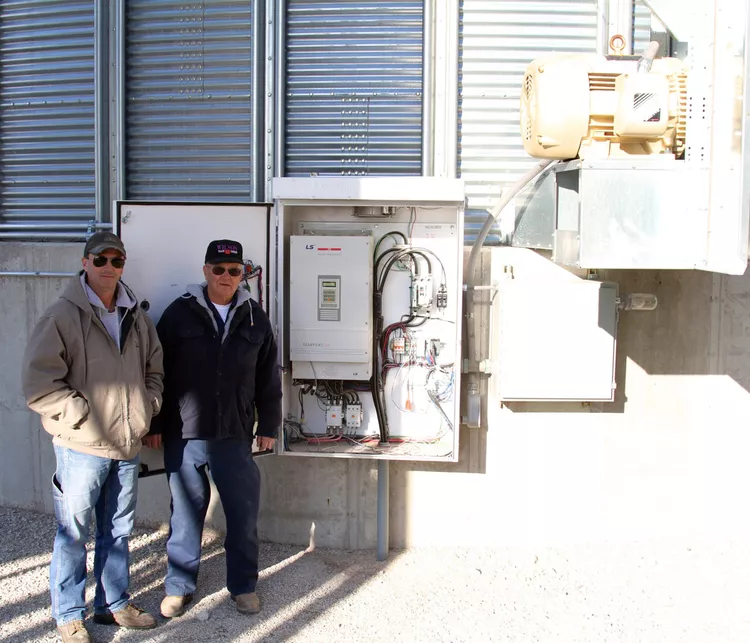Rotary converters
3-Phase Conversions Gain Traction for Grain Dryers
Rotary Phase Converters in South Africa
Rotary Phase Converters in South Africa , When three-phase motors with phase converters were placed on their single-phase service late last year, the father and son both questioned why they hadn’t done it sooner.
Tyler Wynthein, of Arlington, Iowa, farms with his father, David. “I don’t understand the science, but the converter changes the phase of the electricity coming in to allow us to use a three-phase motor,” he explains.
They currently operate two sizable motors that were previously impractical to run on a single phase. It’s not just them who do it. Wynthein’s response is normal, according to John Molumby, customer relations manager for the Allamakee-Clayton Electric Cooperative (ACREC) in northeast Iowa, who reports hearing it often.
“Typically, people wish they had done it a lot sooner. Usually, the price scares them at first. Once they make the change, they wish they had done it in three phases long ago,” Molumby says.
Three-phase availability should be a prime consideration for any operation that needs motors with more than 10 hp., Molumby says. “You don’t have to live where your grain dryer is. You can turn them on and monitor them from home.”
single-phase to 3-phase converter
Key to decision: three-phase availability
Molumby believes that if the three phases are pretty close, it’s affordable to go with the three phases if you can get a new dryer and some financial assistance through the USDA’s REAP program. According to Molumby, ACREC charges $4,600 to “get the three tubs [capacitors] and build the line into them” when three-phase power happens to be available at the farm gate. The standard charge for three phases, if it isn’t at the gate, is roughly $80,000 per mile because it needs closer pole spacing and stronger poles.
To reduce costs, the utility offers revenue consideration. The single-phase service line’s age, reconstruction plans, and consumption level are among the variables.
For example, a grain farm with seasonal needs, perhaps lasting only four weeks a year, has quite different needs than a new dairy, which has a far different usage profile and better revenue consideration. Phase converters, variable-frequency drives (VFD), and soft starts are the first things that utilities, electricians, and system installers bring up when the expenses for complete three-phase service on a grain farm become prohibitive.
utilizing a range of converters
Additionally, ACREC offers rotary and electronic phase converters. Depending on how many motors they are looking at, many members choose a rotary kind or a combination of the two. Phase converters come in two varieties: rotary and electronic.
Rotating is similar to installing a second motor outside to take up two extra phases. When you do that, some efficiency is lost.
Electronic conversion performs somewhat better since it fools the motor into believing it is picking up the other phases.
This method of operating three-phase motors with single-phase supply lines was made possible by the advent of variable-frequency drives in the 1980s, thanks to advancements in solid-state electronics. In the 1990s, programmable circuitry was the first to lower the cost of VFD technology for factories and industries.
They function by first converting the supplied voltage to direct current (DC), which is then transformed into a suitable three-phase source for the motor. They are also referred to as inverters and adjustable-speed drives.
An alternating current (AC) motor, which is often a three-phase induction motor; a solid-state programmable controller; and an interface that allows you to start, stop, and adjust the system are the three subsystems that make up the VFD.
Phase conversion system design, programming, and installation constitute a significant portion of the business of Washington, Iowa-based motor controls specialist Brian Koehler’s Powercom company. He started the business in 2005. It provides direct support to farmers in Iowa and, via its website, to farms in other states.
An example of a standard VFD installation
The topic comes up when new sites require heavy motors and when established farms require a large motor or a power boost. A standard VFD installation is placed next to the motor it controls and constructed inside a 24 by 24 by 8-inch electrical box. Three phases exit and one phase enters.
When farm electricity needs exceed the capability of the largest single-phase 10-hp motors, Koehler says there are only three-phase motors available.
Three-phase motors are less expensive to purchase than single-phase motors for the same horsepower. They require less upkeep, are less problematic, and are more cost-effective to run. There can be hundreds of dollars in variances in front costs, depending on the scale of the system.
Using VFD at the new grain site
In 2007, Koehler used VFDs to address Lonnie Burgmaier and his son Jeromy’s power problems at Creston, Iowa. The Burgmaiers had begun to plan a new eight-acre drying and storage area. It required motors with a maximum horsepower of 75. Upon discovering that the farm could only receive single-phase service, Koehler reached out to Powercom for assistance.
In 2007, Koehler developed the foundational framework, and then in 2010, he added to it. Currently, the location has one 200,000-bushel bin and four 50,000-bushel bins. Koehler utilized a VFD to power a three-phase, 75-hp motor that drives the grain dryer’s fan. The ventilation fans on the large bin are powered by three 40-hp motors with VFD units, and there are four 15-hp motors for the diminutive containers. Three-phase motors are also utilized by the Burgmaiers on two-grain legs that are above the bins and two horizontal conveyors.
“We use a lot of propane with it, but even though the 75-hp motor is single phase, we do not turn down the lights of the neighbors when we turn it on. The benefit of soft starts is precisely that, according to Lonnie Burgmaier. “It’s adjustable, so we start that big motor slowly.”
The Burgmaiers claim that there have been no problems with the system since it was first installed.

